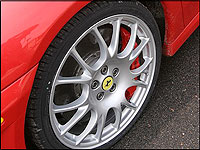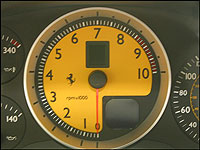Or, one can find a country road and drive it as fast as one dares. In my half-hour on some tight roads around Mont Tremblant, I
 |
| Never has a speed limit seemed so low, nor has the absence of the local police been more appreciated. (Photo: Gerry Frechette, Canadian Auto Press) |
didn't dare very much, looking at it as more of an opportunity to feel out the car in real-world conditions - and to revel in the attention from onlookers. In rural Quebec, of course, those road conditions are only slightly smoother than the surface of the moon, the Department of Highways' idea of road maintenance being to throw a little asphalt at the potholes each spring.
Given the roads, the F430 handled itself with aplomb, never feeling at all skittish at the occasional....okay, frequent....extra-legal speeds it happily delivered. Never has a speed limit seemed so low, nor has the absence of the local police been more appreciated.
The driver-machine interface was one that pleasantly surprised me on several levels. The old stories of Ferraris and other Italian cars requiring very long arms and short legs are long-gone, as my 6'2" frame was quite well-accommodated, even in head room. The seats were supportive in all the important directions, and again, no less would be expected.
 |
| The tach, big and yellow, sits dead center in the instrument panel. (Photo: Gerry Frechette, Canadian Auto Press) |
The tach, big and yellow, sits dead center in the instrument panel.
Visibility out, while not that of a sedan, is reasonable, especially with there being no rear spoiler of any kind to block the view. All the aerodynamic trickery on the F430, developed in the F1 program, is under the car.
The driver can select one of five settings for the electronics and driveline, via the "manettino" switch on the steering wheel. Almost laughably, the "safest" choice with the most intervention is called "Ice" (as if....), and it says here that no F430 will ever be driven with this setting.

